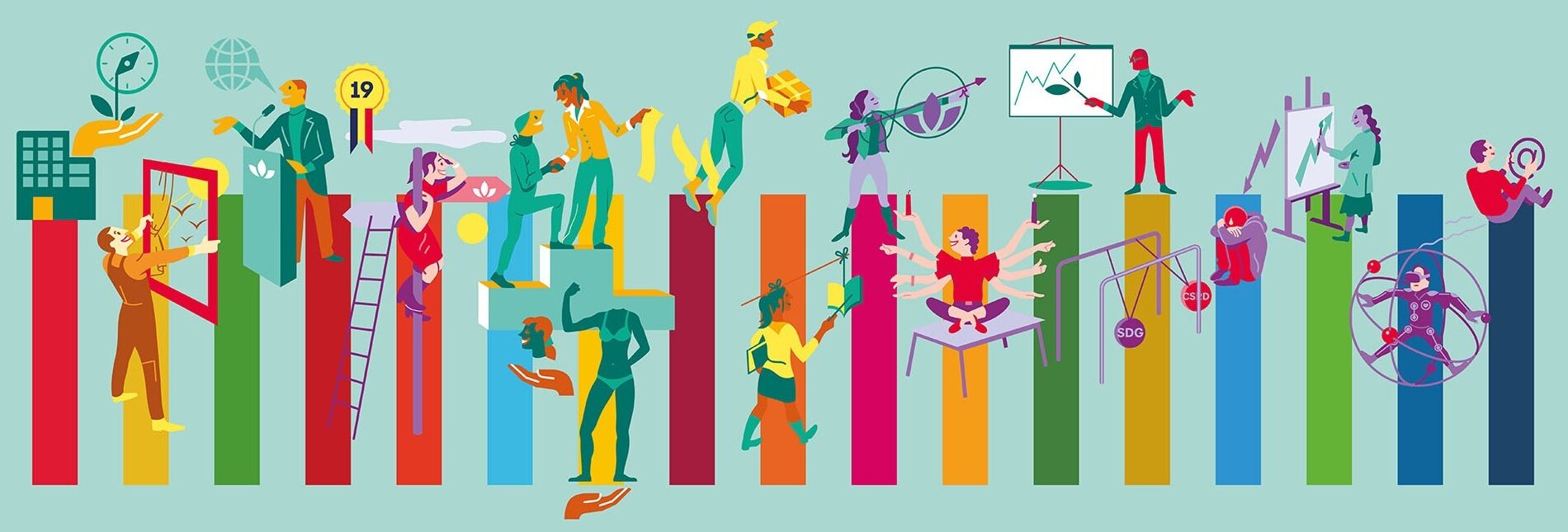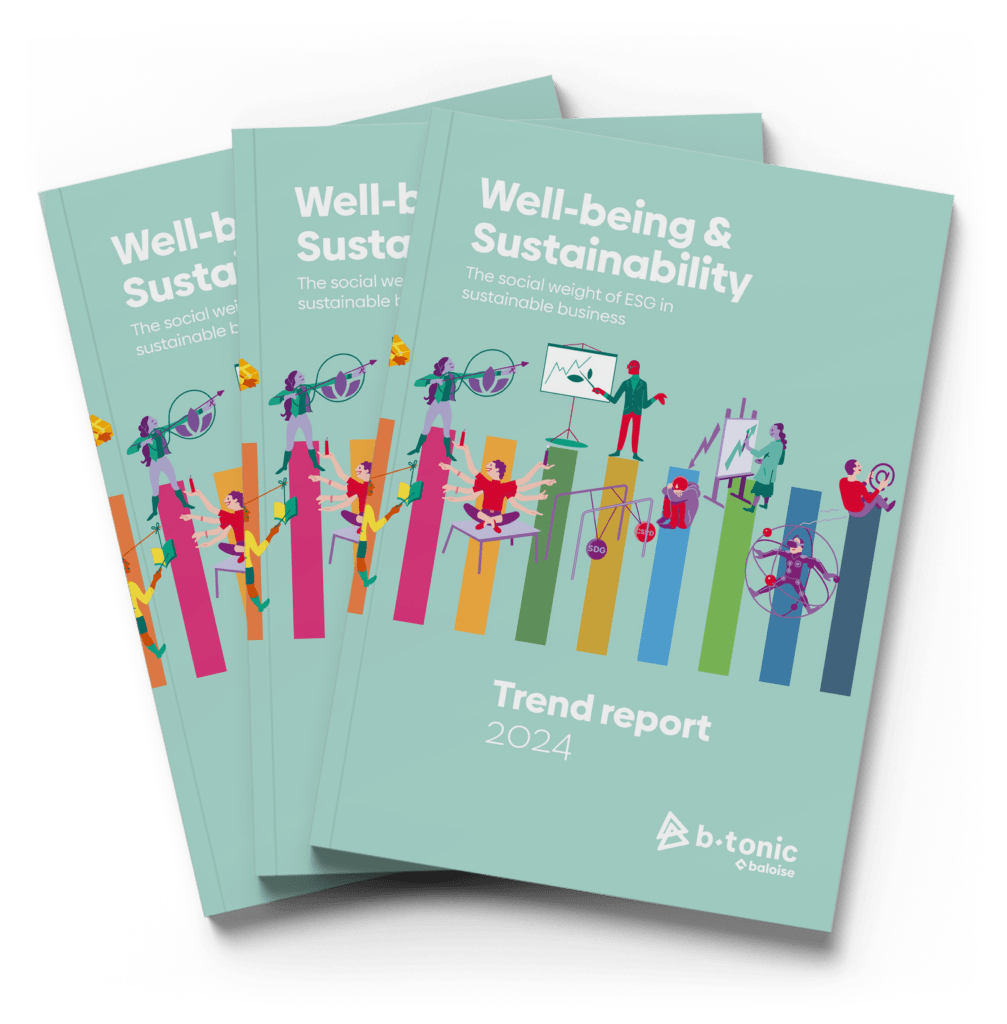Sustainable Development Goals

The SDGs lead the way
Content:
Doing the right thing has few disadvantages
- To a viable model of growth
- Societal interest ≥ corporate interest
- Well-being becomes profit
- How enticing is your well-being policy?
- CSRD increases pressure
The SDGs set the course that we must sail as entrepreneurs, policy makers, individual citizens. They are a response to the risks that threaten our world and planet and that are inextricably linked. At the same time, those risks are so far-reaching that we cannot tackle them individually.
The SDGs ensure your company’s future
Already in 2012, during the Conference on Sustainable Development in Rio de Janeiro the United Nations (UN) decided to formulate a number of universal goals in response to the urgent social, economic and environmental challenges that plague the planet and society.
On 25 September 2015, 193 member states signed the ‘Agenda 2030 for Sustainable Development’ and
they embedded the world’s most important societal challenges in a plan of action with 17 sustainability goals, the so-called Sustainable Development Goals (SDGs) and 169 subgoals. Together they are the cornerstone to eliminate poverty by 2030, tackle inequality and protect world peace. And thus ensure your company or organisation’s future.
Before 2015, sustainable development always revolved around the three Ps: People, Planet and Prosperity. The SDGs add two Ps: Peace and Partnership. The term peace is the foundation for other pillars and was added because of that. Partnerships are considered to be indispensable to reach the SDG objectives as well.
The end goal of those 17 goals? To build a sustainable world in its global nature. In other words, a world that is ‘socially just, ecologically safe and economically prosperous’. The field of application is very broad. It tackles health and education, decent employment, well-being, sustainable production and consumption patterns, but the preservation of ecosystems as well. Or even the reduction of inequality within and between nations.
‘The SDGs describe the only viable model for long-term growth’
With these goals, leaders of 193 nations recognise that the SDGs endorse that the elimination of poverty needs to be coupled with strategies boosting economic growth and meeting a number of societal needs, such as health, childrearing, social protection and job opportunities. And that these strategies need to combat global warming and protect the environment.

The 17 universal goals are supported by 169 subgoals and a multitude of concrete indicators [1] with which the UNSTAT (United Nations Statistics Division) monitors and measures the progress in the achievement of the (sub)goals. Governments get tangible guidelines to align their policies with the SDGs. The challenges are naturally different in each country, but that is no reason to cherry-pick some goals and ignore others. There are no priority goals, only priority actions.
A study commissioned by the Federal Institute for Sustainable Development (FIDO in Dutch) keeps track of the SDG progress in Belgium and indicates important issues[2]. On the website of the Federal Plannign Bureau [3] you can also find the most recent information on our country’s progress. And we are heading into the right direction. With a SDG Index score of 79,7 (in 2000 that was only 73,8), our country takes the 18th place in the ranking of 193 member states of the UN [4].
[1] ‘Official List of Proposed SDG Indicators.pdf’, view https://www.sdgs.be/nl/sdgs
Sustainable Development Goal indicators website: https://unstats.un.org/sdgs
[2] https://www.sdgs.be/nl/news/waar-staat-belgie-met-het-behalen-van-de-sdgs
[3] https://www.plan.be/aboutus/overview.php?lang=nl&TM=41
[4] https://dashboards.sdgindex.org/rankings
Societal interest becomes corporate interest … and vice versa
Aiming for a sustainable and habitable world is no zero-sum game. We all strive for change, but none of us is dying to do it. Nevertheless, the fundamental shift will be inevitable. Either nature will force mankind to change, or we will become smart enough to prepare for a new and sustainable world in time.
Such a shift only has a chance if it is supported by a proactive (business) model that tackles the challenges of the world, a model with a positive impact on society. The ‘purpose’ must take centre stage. After all, if a company can’t explain what it is doing to influence the world’s challenges in a positive way, why should we as citizens allow that company to exist? Fortunately, people are realising that ‘doing nothing’ will cost us more than taking action. In fact, the SDGs and the tangible way companies implement the sustainability goals into their business DNA become their licence to operate. Without licence no future!
Seven years after the launch the SDGs have developed into a code shared by all companies and organisations that consider sustainable entrepreneurship to be fundamental to the survival of their activities. In fact, the SDGs are an indispensable compass for companies and organisations in the direction of new (market) opportunities, a guideline to maximise the positive impact of their activities. Those who do not realise this are making a grave mistake. Doing nothing is negligence. Doing the right thing has few disadvantages. The societal and planetary challenges are huge, but the business opportunities are just as great. Besides, sustainable entrepreneurship is a must to uphold the company’s reputation and to guarantee the licence to operate.
Let’s be realistic: the economic growth mindset is not immediately going to be a perfect match with the finality of the SDGs and vice versa. But they have kickstarted an irreversible process. Niet de deadline van 2030 is de grootste verdienste, wel dat ze een afgebakende structuur en duidelijke visie bieden om het economisch model dat we midden 19e eeuw vormgaven, te herdenken op macro- en microniveau. The biggest achievement is not the 2030 deadline but the fact that they provide a well-defined structure and clear vision to rethink the economic model we shaped in the middle of the 19th century on a macro and micro level. “I am not against economic growth in principle, I am against how we currently define it”,the Slovenian economist dr. Janez Potočnik says, who is also considered to be the ‘architect of the circular economy’.. “We need to get rid of the GDP as the sole benchmark of growth. I like to explain the logic of the GDP with the following saying: you don’t achieve your goals by walking faster if you’re going in the wrong direction. We desperately need alternative indicators that start from well-being or benchmarks that are more correct and better adapted to the economy of the future.
‘The societal and planetary challenges are huge, but the business opportunities are just as great’
Top 5 SDGs with direct impact on well-being The indicators based upon which you can monitor the execution of the SDGs, are principally meant for...
How to build a well-being culture? The World Health Organization defines health as the sum of an ultimate physical, mental and social well-being. That inherently...
CSRD – Who needs to report when? The application fo the CSRD happens in three phases. The scale of your company determines in which phase...
Good life goals translate SDGs into everyone’s life The Good life goals focus on the individual to achieve the ambitions of the SDGs. In the...
What are the Good work goals? The Good work goals aspire to a working environment that is safer, healthier, more resilient, more inclusive, happier, more...
‘Those who offer solutions will be the winners’ Siviglia Berto, Managing Director of B-Tonic, explains why the SDGs are so important for B-Tonic’s ‘why’ and...









